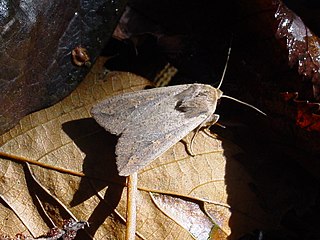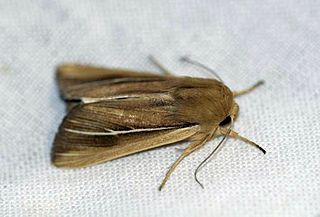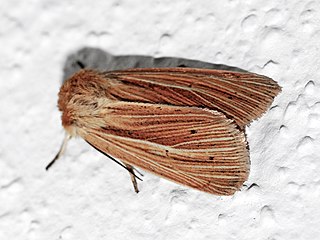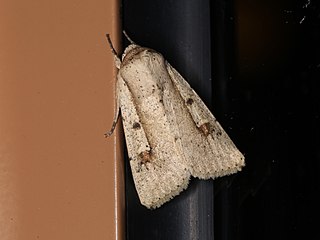
Mythimna ferrago, the clay, is a moth of the family Noctuidae. The species was first described by Johan Christian Fabricius in 1787. It is distributed throughout Europe and is also found in Morocco, Algeria, Turkey, Asia Minor, Armenia, Syria, Turkestan, Israel, Lebanon, Iraq, Iran, Central Asia and the western parts of temperate North Asia. Also Tibet.

Mythimna impura, the smoky wainscot, is a moth of the family Noctuidae. The species was first described by Jacob Hübner in 1808. It is distributed throughout most of the Palearctic realm from Ireland in the west of Europe east to the Caucasus, Turkey, Syria, Kazakhstan, Russia, Siberia, Mongolia, then Japan. In Europe it is found from the Arctic Circle to Spain and Italy in the south, as well as in the northern regions of Greece.

Mythimna pallens, the common wainscot, is a moth of the family Noctuidae distributed throughout the Palearctic realm from Ireland in the west, through Europe to Central Asia and Amur to the Kuriles in the east. The species was first described by Carl Linnaeus in his 1758 10th edition of Systema Naturae.

Mythimna is a genus of moths in the family Noctuidae described by Ferdinand Ochsenheimer in 1816.

Mythimna albipuncta, the white-point, is a moth of the family Noctuidae. The species was first described by Michael Denis and Ignaz Schiffermüller in 1775. It is distributed throughout Europe and one subspecies is found in Tunisia. It is also found in Asia Minor, Armenia, and Iran, and the northeastern United States.

Mythimna unipuncta, the true armyworm moth, white-speck moth, common armyworm, or rice armyworm, is a species of moth in the family Noctuidae. The species was first described by Adrian Hardy Haworth in 1809. Mythimna unipuncta occurs in most of North America south of the Arctic, as well as parts of South America, Europe, Africa, and Asia. Although thought to be Neotropical in origin, it has been introduced elsewhere, and is often regarded as an agricultural pest. They are known as armyworms because the caterpillars move in lines as a massive group, like an army, from field to field, damaging crops.

Mythimna vitellina, the delicate, is a moth of the family Noctuidae. The species was first described by Jacob Hübner in 1808. It is mainly distributed throughout southern Europe and the southern part of eastern Europe. It is also found far less commonly further north in Europe. Also in North Africa, the Near East and Middle East, Central Asia and western China.

Mythimna straminea, the southern wainscot, is a moth of the family Noctuidae. The species was first described by Georg Friedrich Treitschke in 1825. It is found in the western parts of the Palearctic realm, including Morocco, Europe, Turkey, the Caucasus, Israel, and Lebanon.

Mythimna separata, the northern armyworm, oriental armyworm or rice ear-cutting caterpillar, is a moth of the family Noctuidae. It is found in China, Japan, South-east Asia, India, eastern Australia, New Zealand, and some Pacific islands. It is one of the major pests of maize in Asia. The species was first described by Francis Walker in 1865.

Mythimna convecta, the common or Australian armyworm, is a moth of the family Noctuidae and is found in Australia. The wingspan of the moth is about 40 mm.

Mythimna turca, the double line, is a moth of the family Noctuidae. The species was first described by Carl Linnaeus in 1761. It is found in Europe. The eastern expansion extends through northern Asia and central Asia to northern China, Korea and Japan. It rises to a height of about 700 metres in the Alps.

Mythimna conigera, the brown-line bright-eye, is a moth of the family Noctuidae.

Mythimna litoralis, the shore wainscot, is a moth of the family Noctuidae.

Mythimna congrua is a species of moth of the family Noctuidae.

Zoila friendii is a species of sea snail, a cowry, a marine gastropod mollusk in the family Cypraeidae, the cowries.

Mythimna prominens is a moth of the family Noctuidae. It was described by Francis Walker in 1856. It is found on Malta and in Greece, France, the Iberian Peninsula and Italy. Outside of Europe, it is found in Morocco, the Republic of the Congo, the Democratic Republic of the Congo, Kenya, Réunion, Madagascar, Nigeria, South Africa and Zimbabwe.

Mythimna anderreggii is a moth in the family Noctuidae. It is found in the mountains of Europe. It is also present in the northern Caucasus, the Gissar Range, the Pamir mountains and the Tian Shan mountains.

Leucania yu is a moth of the family Noctuidae first described by Achille Guenée in 1852. It is found in Oriental tropics of India, Sri Lanka, the Andaman Islands, Hong Kong, Indonesia, the Philippines, Taiwan east to Australia, Fiji and Tonga.

Plexippus petersi is a species of jumping spider native to Asia that has been introduced to Africa and Pacific islands. The male is between 6 and 10 mm in length, and the female is around 10 millimetres (0.39 in). This spider is commonly known as the tropical flycatcher or small zebra jumper.

Epichloë scottii is a haploid sexual species in the fungal genus Epichloë. A systemic and seed-transmissible grass symbiont first described in 2022, Epichloë scottii is a basal lineage branching prior to Epichloë glyceriae, and is the previously unidentified ancestor of the hybrid Epichloë species, Epichloë disjuncta.


















